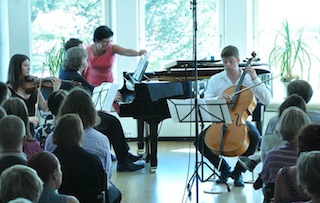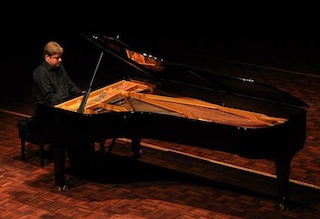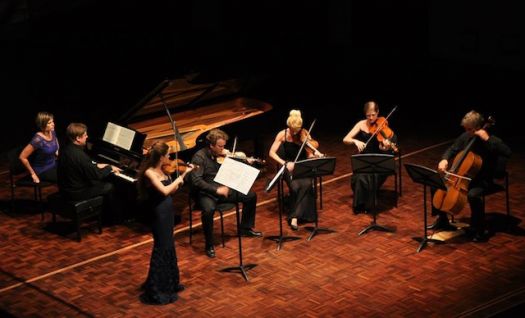
Chamber Music Enriches Pärnu Music Festival
Chamber
music is a vital element of the Pärnu Music Festival in Pärnu, Estonia, now
entering its third year from July 16-23. The quantity and quality of talent
participating, from guest artists to members of the top-flight Festival
Orchestra, is quite high, making smaller ensembles some of the choice offerings
during the eight-day event.

Worthy of special note this year have been:
· A concert featuring chamber music by Sibelius July 17 at the Pärnu Beach Hotel
· “Peeter Laul and Friends,” with Wagner/Liszt transcriptions performed by Russian pianist Laul and Ernest Chausson’s Concerto for Violin, Piano and String Quartet July 17 at Pärnu Concert Hall
· the Pärnu Music Festival Gala July 20, also at the Concert Hall, with an abundance of chamber works performed by Festival artists.
Each offered something special and contributed significantly to the diversity of this newly created musical festival on the shores of the Baltic Sea.
Sibelius is best known for his symphonic works, but he left a considerable body of chamber music as well, including four string quartets (the best known being Op. 56, “Voces Intimae”), five piano trios, a piano quartet and a piano quintet. Heard July 17 were his atypical Quartet Ljunga Wirginia for violin, cello and piano four-hands (1885), the Piano Trio “Korpo” in D Major (1887) and “Valse Triste,” transcribed for violin, cello and piano four-hands by Finnish pianist Peter Lönnqvist.
This critic missed the Ljunga Wirginia Quartet, a work with a dramatic subtext, but heard both the “Korpo” Trio and “Valse Triste.” Performing were violinist Miina Järvi, cellist Marius Järvi and pianist Folke Gräsbeck, joined in “Valse Triste” by pianist Mihkel Järvi. In three movements, “Korpo” (named for Korpo Island in Finland) presents a dramatic opening movement, a complex Fantasia second movement with a hymn-like Andantino, and a dance-like finale with a syncopated kick. All were performed most convincingly by the trio, who were rewarded with enthusiastic rhythmic clapping by the crowd.
“Valse Triste” was florid and dramatic from beginning to the three chords that bring it to its final, plaintive end. Also on the program was the Grieg Cello Sonata (you can hear hints of his A Major Piano Concerto in the first movement), where Marius Järvi displayed a luxuriant tone, applied with keen expression, accompanied by Mari Järvi.
Later
in the evening at the Pärnu Concert Hall, pianist Laul provided an arresting
tribute to Richard Wagner on his centenary. It might have been Liszt himself,
on the keys, so amazing was Laul’s ability to execute these virtuosic
showpieces, including “Elsa’s Dream” and “Procession to the Cathedral” from
“Lohengrin,” “Spinning Song” from “The Flying Dutchman,” “March to the Holy
Grail” from “Parsifal,” “Liebestod” from “Tristan and Isolde” and the Overture
to “Tannhäuser.” There was bravura to burn in these pieces and plenty of
lightness, as well, always in tune with the musical moment. Particularly
stirring was the conclusion of “Parsifal” and needless to say, the “Liebestod”
built to a shattering climax.

Chausson’s
1891 Concerto for Piano, Violin and String Quartet (so-named because of the
prominence of the piano and violin parts) was a revelation and daunting achievement
in the hands of Laul, violinist Anna-Liisa Bezrodny and a quartet comprising Lasse
Joamets and Vivika Sapori-Sudemäe on violin, violist Johanna Vahermägi and
cellist Leho Karin. Following
three big strokes of a germinal motto theme, Bezrodny entered with a luscious
exposition. The gentle, rocking theme of the Sicilienne gave way to more
sweeping passages, and the Grave which followed grew quite intense. Most
remarkable for sheer stamina on Bezrodny’s part was the Très animé finale where she played constantly in the highest register of her
instrument (an observation applicable to the work as a whole, perhaps for
reasons of projection and balance).

A gala concert by the Festival guests is a regular feature of the Pärnu Music Festival. The year’s gala brought together 25 superb musicians, including a viola quartet (performing a transcription of the Chaconne from Bach’s Partita No. 2 for Solo Violin), a horn quartet (in music by Bruckner and Humperdinck), an ensemble of nine instruments performing Witold Lutoslawski’s Dance Preludes, a bassoon/clarinet duo (Poulenc’s Sonata for Bassoon and Clarinet), plus the Piano Quartet in C-sharp Minor by Estonian composer Eduard Tubin and Brahms’ String Sextet No. 1 in B-flat Major. It was, in a word, a feast.
Lutoslawski’s five aphoristic pieces, ranging from brisk and frisky to soulful and expansive, were given performances to match by violinist Kirsti Kuusk, violist Peijun Xu, cellist Andreas Lend, bassist Nikita Naumov, flutist Heili Rosin, oboist Riivo Kallasmaa, clarinetist Toomas Vavilov, bassoonist Peeter Sarapuu and French hornist Samuel Seidenberg. Bassoonist Martin Kuuskman and clarinetist Matthew Hunt did the honors for Poulenc’s Sonata, giving it bounce, romance and a big dose of high-spirits.
The horn quartet – Seidenburgs all and related (Samuel, Mirjam, Sulamith and Aaron) – brightened the evening with an Andante in D-flat Major by Bruckner (transcribed by Michael Holtzel) and “Evening Prayer” from Humperdinck’s opera “Hansel and Gretel.” Their encore was pure fun, “Fidele Grünröcke Marsch” by Alfred Diewitz.
The viola quartet – violists Mikhail Zemtsov, Julia Dinerstein, Dana Zemtsova and Andres Kaljuste, all fine players – did not fare as well in Bach’s Chaconne, sounding heavy and dark in contrast to the lightness and agility the solo violin can achieve. Violist Pejun Xu and cellist László Fenyö had a more congenial task with duos by Hindemith, Beethoven (Minuetto from “Duet with Two Eyeglasses Obligato”) and Mozart (Andante Cantabile from the Duo for Violin and Viola, K. 424, arranged for viola and cello).
Tubin and Brahms filled out the balance of the program. Tubin’s single-movement Piano Quartet – violinist Mari-Liis Päkk, violist Kaljuste, cellist Jason Calloway ad pianist Sophia Rahman – was well-played and romantic, with a dance-like conclusion. Brahms’ Sextet, which followed, was one of the highlights of the evening. Violinists Arvo Leibur and Sandis Steinbergs, violists Mikhail and Dana Zemtsov and cellists Andreas Lend and Marius Järvi crafted the delicious sounds in which it is drenched. This is warm, sunny Brahms, with a dramatic theme and variations (led off beautifully by Mikhail Zemtsov on viola), followed by a bracing Scherzo and a cheerful finale.